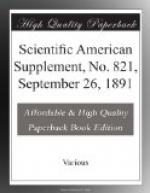Hoffman also deprived dogs of fat for a month, causing them to lose as high as twenty-two pounds weight, then began nourishing with bacon fat with but little lean; the quantity of fat formed in five days, in the dog that lost twenty-two pounds, was more than three pounds, which could have been derived only from the bacon fat.
It has been stated, however, that alimentary fat seems to preserve from destruction the fat of the organism which arises from other sources. Be this as it may, it is a fact that the pre-existence of fat furthers the accumulation of more adipose; or in other words, fat induces fattening!
That adipose may be formed through the transformation of albuminous matters (meat) is an extremely important corollary, one established beyond cavil by Pettinkofer and Voit, in an indirect way, by first estimating the nitrogen and carbon ingested, and second the amount eliminated. Giving a dog meat that was wholly deprived of fat, they found it impossible to recover more than a portion of the contained carbon; hence some must necessarily have been utilized in the organism, and this would be possible only by the transformation of the carbon into fat! It goes without saying, however, that the amount of adipose thus deposited is meager.
Other facts also plead in favor of the transformation of a portion of albumen into fat within the economy, notably the changing of a portion of dead organism into what is known as “cadaveric fat,” and the very rapid fatty degeneration of organs that supervenes upon certain forms of poisoning, as by phosphorus.
The carbohydrates, or more properly speaking hydrocarbons, are regarded by all physiologists as specially capable of producing fat, and numerous alimentary experiments have been undertaken to prove this point. Chaniewski, Meissl, and Munk obtained results that evidenced, apparently, sugar and starch provide more fat than do the albuminoids. Voit, however, disapproves this, maintaining the greater part of the hydrocarbons is burned (furnishes fuel for the immediate evolution of force), and that fat cannot be stored up unless a due proportion of albuminoids is also administered. He believes the hydrocarbons exert a direct influence only; being more oxidizable than fats, they guard the latter from oxidation. This protective role of the hydrocarbons applies also to the albuminoids.
We may believe, then, that the three great classes of aliment yield fat, in some degree; that alimentary fat may be fixed in the tissues; and that hydrocarbons favor the deposition of adipose either directly or indirectly.
It is well understood that fat may disappear with great rapidity under certain conditions; many maladies are accompanied by speedy emaciation; therefore, as fat never passes into the secretions, at least not in appreciable quantities, it probably undergoes transformation, perhaps by oxidation or a form of fermentation, the final results of which are, directly or indirectly, water and cadaveric acid. It is certain the process of oxidation favors the destruction of adipose, and that everything which inhibits such destruction tends to fat accumulation.




